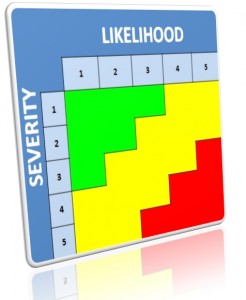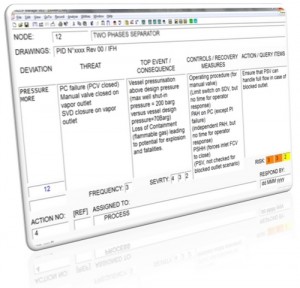The methodology for process hazard analysis
Definition
HAZOP is a useful design review tool developed originally for continuous production processes. The technique was developed by ICI (Imperial Chemical Industries) in the 1960s for use in design studies of chemical and petrochemical plants. The HAZOP technique was propagated and came into general use in 1977 through the Chemical Industries Association and it is now seen as Industry standard. It has been adopted by many industries and its use is now worldwide following the IEC 61882 (Hazard and operability studies (HAZOP studies) – Application Guide).
The HAZOP method has been extended to be applicable on all types of processes and can be employed on almost any production system (continuous, sequenced or batch). Various methods have also been developed to enable HAZOP to cover every phases of a project:

↑
Objectives
The HAZOP (Hazard and Operability) method was developed:
A HAZOP study can be used at varying times during the life cycle of the installation, from process development through to the closure of the plant, including hazard assessment carried out on any modifications proposed during its operational life span.
The HAZOP process follows 4 steps:
These four steps are the basis of HazOptima LOGO.

↑
HazOptima
HazOptima provides high quality HAZOP reviews based on very effective leaders to head up the HAZOP team. Our chairmen are highly experienced and completely focused on HSE reviews, having both a Safety and a Process background. This ensures a broad and extensive knowledge of the given industrial context that enables us to find out unexpected issues, and guide the team to the optimized solution.

The HAZOP reviews can be:
Our goal is to ensure:
The proper procedure for the relevant review at the best time.
Our services deal with HAZOP reviews preparation, facilitating, reporting, follow-up and training.
We can work for all industries where streams can generate hazards.
Click to see our last references.
↑
FAQ
What is the result of a HAZOP review?
The HAZOP review is the documented demonstration of risk acceptability. This can be of a qualitative or a semi-quantitative type. The report shall include the list of actions recommended or mandatory to achieve the acceptable level of risk.

HazOptima reports include a clear and exact record of discussions raised during the review, as well as actions list and dedicated action sheets for easier response and follow-up.
We employ the main software available on the market when carrying out our reviews and more specifically HAZOP Manager developed and produced by Lihou Technical & Software Services.
What is the basic methodology of HAZOP reviews?
In few words, the basic HAZOP methodology is the following one:
This is only the basic process that can be further developed to include risk ranking, action categorization, etc.
For more information please contact us.
What do you need to perform HAZOP reviews?
HAZOP reviews can be performed on P&IDs (Piping and Instrumentation Diagrams), PFDs (Process Flow Diagrams), or other document. HazOptima helps you to identify the requisite documentation according to your constraints and objectives.
What is the scope of HAZOP reviews?
The scope of HAZOP reviews can vary significantly dependent upon your objectives, the project phase, information availability, type of process, and overall organization within your Company. HazOptima helps you to come up with the best procedure including scope of work, rules and planning.
How long do HAZOP reviews take?
Depending on the number of P&IDs and the scope defined in the HAZOP procedure, reviews could take from one day to several weeks or months. HazOptima can help you to define your planning at an early stage in the project.
For more information please contact us.
↑
Bibliography/References

